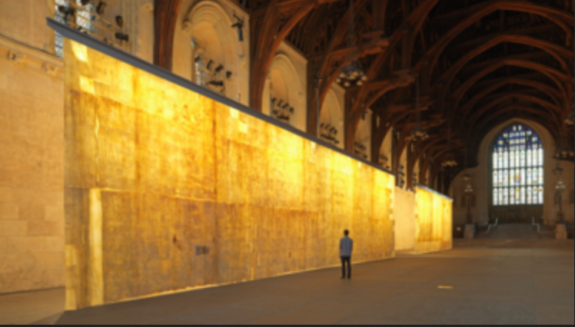On Monday, The Center for Science and Society tackled the topic weighing on everyone’s minds: Dust.
It’s all around us. It’s in our homes, on our bodies. No matter how hard you try to keep your life from falling into decay with feather sweepers and microfiber cloths, it always comes back.
Dust.
But is our omnipresent microscopic companion really all that bad? This is just one of the questions panelists Dr. Gisela Winckler and Dr. Jorge Otero-Pailos addressed during this presentation and open-table discussion.
On the surface, these two PhDs seem to have little in common. Dr. Winckler is a physicist, isotope geochemist, and biogeochemist. Dr. Otero-Pailos is an artist, architect, and preservationist. While Dr. Winckler primarily focuses on climate science, the title biogeochemist itself indicates the immense degree to which her work is cross-disciplinary. Likewise, Dr. Otero-Pailos creates art with history, anthropogenic emissions, and the broader human story in mind.
Yet they are united in their appreciation for all things dusty.
Dr. Winckler kicked off the night by recontextualizing dust. While it is true that the world of science, her world, often uses the dry, technical definition of dust as particles suspended in air, Dr. Winckler prefers the conception put forth by artist Agnes Denes in her work “The Study of Dust.” To Denes, dust is the dispersed yet particular pieces of entropy that catalog our inevitable descent into disorder. Yet dust also settles again into a fine film, preserving disorder in a perfectly balanced and beautifully structured blanket for the world. From this contradiction, Dr. Winckler proceeded.
Dr. Winckler deals with dust on a macro level. Dust is a prominent form of pollution and has had major impacts on anthropogenic climate change, though not in the way that you may think. Dusty pollutants actually contribute to global cooling because of their contribution to albedo, or the Earth’s reflectivity. Unlike greenhouse gasses, dust particles don’t allow sunlight to pass through them. Particles also provide a point around which clouds can form, another reflector. Dust is like an umbrella on a sunny day.
Clouds of dust, such as those from the Sahara Desert that dump sediment into the Atlantic Ocean, also play a key factor in mitigating global warming. Inside these particulate masses are fertilizing minerals, especially iron, which stimulate the growth of marine microorganisms. These phytoplankton and algae are the biggest carbon sink on planet Earth, converting more carbon dioxide into oxygen than all of the forests in the world combined. This has prompted many scholars, Dr. Winckler included, to ask whether we should artificially add iron to the oceans to biochemically combat the warming effects of greenhouse gas emissions.
But Dr. Winckler is more concerned with treating dust as a tool for the history of climate than she is with altering the future of it, at least for now. For this reason, she spends much of her time researching the dust deposits recorded in two unlikely regions: the insides of glaciers and the muck at the bottom of the ocean. Reading these records gives Dr. Winckler insight into precise changes in atmospheric dust, from isolated volcanic eruptions to the explosive increase following the Industrial Revolution. She even found evidence of particulate concentration changes due to one iron mine in Roman Spain in ice cores taken from Greenland.
Coincidentally, Dr. Otero-Pailos worked on this very mine. His passions as an artist and preservationist has led him to remove centuries of dust deposits from historical monuments and preserve them in the form of massive, thin sculptures. To make these, he coats monuments (or mines) in a special kind of latex that strips away all of the packed on grime of years past while also preserving it as a unitary physical object. His work simultaneously cleans and creates. These sculptures are the haunting after-images of human achievements memorialized by the very emissions created by them.

To Dr. Otero-Pailos, the collected dust from monuments and iron mines brings to life the complexities of the memorial project. Every statue, cathedral, and palace built throughout history contributes to the global network of pollution that then settles around the world and collects on other structures. More than that, every cooking fire, coal stove, and cigarette smoked in the world contributes to this collection of particles as well. Monuments– and art generally– can be, has been, and will continue to be used as an exclusionary weapon to keep institutions elite. But dust is a communal endeavor. We don’t all contribute to the same degree or from the same necessity, but all of our fingerprints can still be seen on the grime that coats the Empire State Building, the Louvre, and the Great Wall of China.
Dr. Otero-Pailos preserves the memory of this varied collective contribution long after it has been wiped away.
So is dust ethical? It seems that both panelists agree this is the wrong question to ask. Is how we study dust ethical? Is how we create dust– from pollution to eco-engineering– ethical? Is monumentalizing the unintentional stains we leave behind ethical? Conversations like this panel discussion don’t answer all of our questions, but they do make us ask them in more thoughtful ways.
If this event sounds interesting, consider attending some of the others put on by The Center for Science and Society every week, the complete list of which can be found on their website.
The Ethics of Dust Panel Discussion via The Center for Science and Society.
The Ethics of Dust: Westminster Hall via Jorge Otero-Pailos.


 0 Comments
0 Comments